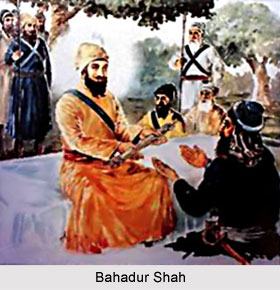 Bahadur Shah I, also known as Muazzam Bahadur Shah and Shah Alam I was a Mughal emperor who ruled India from 1707 to 1712. Born in October 14, 1643, in Burhanpur, Bahadur Shah I was the second son of the emperor Aurangzeb and Nawab Bai Begum Saheba, the daughter of Raja of Rajauri (Jarral Rajput). In his father`s lifetime, Bahadur Shah I was appointed as the governor of the Northwest Territories by Aurangzeb. His province included some parts of the Punjab where the Sikh faith was growing eventually.
Bahadur Shah I, also known as Muazzam Bahadur Shah and Shah Alam I was a Mughal emperor who ruled India from 1707 to 1712. Born in October 14, 1643, in Burhanpur, Bahadur Shah I was the second son of the emperor Aurangzeb and Nawab Bai Begum Saheba, the daughter of Raja of Rajauri (Jarral Rajput). In his father`s lifetime, Bahadur Shah I was appointed as the governor of the Northwest Territories by Aurangzeb. His province included some parts of the Punjab where the Sikh faith was growing eventually.
As governor, Bahadur Shah I made the enforcement of Aurangzeb`s severe laws quite flexible and an anxious calm prevailed in the province for a brief time. In fact, Bahadur Shah I maintained a sociable relationship with the last Sikh spiritual leader, Guru Gobind Singh. When Bahadur Shah I was challenging his brothers for succeeding the Mughal throne, Guru Gobind provided sufficient military assistance and devout guidance to the liberal prince.
Bahadur Shah I took the throne after Aurangzeb`s death and a war of succession began immediately after Aurangzeb`s death. One younger brother, Prince Azam Shah, announced himself emperor and marched towards Delhi, where he ineffectively fought with Bahadur Shah I and died after an insignificant reign of three months. Another brother, Muhammad Kam Baksh, was killed in 1709 for the same reason.
Aurangzeb had imposed Sharia law within his kingdom with harsh enforcement of strict pronouncements. This led to amplified militancy by many constituencies including the Marathas, the Sikhs and the Rajputs. Thus, revolt was widespread at the time of Aurangzeb`s death and Bahadur Shah I inherited a very unbalanced political environ. Bahadur Shah thought of improving relations with the militant constituencies of the rapidly crumbling kingdom. He was a more moderate man than his father and was successful in retreating Banda Bahadur to hills and gain control over Assam purely because of the support he got from his son, Azim-ush-Shan.
Bahadur Shah I never eliminated jizyah, but the effort to assemble the tax became useless. Sustaining to music was actually improved during his concise rule of five years. There was no devastation of temples in his reign. During Bahadur Shah I `s brief rule of around five years, although the empire remained integrated, factionalism in the decency reached a new height. However, Bahadur Shah I could do little to moderate the damage already done by his father. Indeed, Bahadur Shah I `s shortcomings could not be really accessed, except for his lack of military skills and old age added to the problems of the empire.
Bahadur Shah I expired on February 27, 1712 in Lahore. His son Jahandar Shah succeeded him.



















